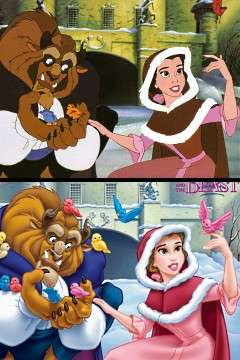Detail-Hogging Cover
"The video market is anarchic and not judged by reason, but by kids whose parents tell them "You can buy ONE video while we're here." Those kids rush and get the thing with the most appealing cover, despite what's coded on the DVD."—Platypus Comix explains how Scooby Doo Meets Batman (cover) made the Top 10 Video Sales Chart for five consecutive weeks.
In animated works, pictures by definition have to move, which means that the more detailed a given frame is, the more time and effort it takes to produce, and the more visible any mistakes made in color shading or lighting will be. As a result, even in the most well-crafted animated works, frames of actual animation footage may intentionally leave out subtle details to make the end result animate more smoothly.
Covers, however, and other kinds of art that are not part of the actual footage don't have that problem. They are just one static picture, and the production company can afford to invest more effort in them. Take the page picture, for example: The top part is a frame taken during the actual movie, and the bottom is the exact, same scene redrawn for its inclusion in The Merch.
This can also apply to comics when comparing the interior pages to the cover: The interior pages require the artist(s) to distribute their efforts across multiple panels, whereas the cover art is created separately, so the cover artist(s) can invest a greater amount of effort and detail.
Compare Action-Hogging Opening, Animation Bump, Limited Animation, Covers Always Lie.
Contrast Minimalistic Cover Art.
Anime and Manga
- Lots of Omake art for Anime and Manga.
- Even more so, the break between the art in many Manga and their Anime adaptations is huge. See anything by Oh! Great (Air Gear, Tenjou Tenge, etc.)
- Most Humongous Mecha have 'mechanical designs' and 'animation models' where the latter is a simplified-for-animation version of the former.
- The cover of anime film Space Thunder Kids DVD contains rather high quality drawings of things that have nothing to do with the very sub-standard animation.
Comic Books
- Something similar happens to Comic Book covers. Many comic covers from the 1980s onward are basically ten years ahead of the interior in terms of color complexity.
Video Games
- A lot like video game box art and advertising, as long as it doesn't change the look enough to turn into Covers Always Lie.
Western Animation
- Basically all Disney works have this, but it especially applies with their low budget Direct to Video films.
- The Disney Princess merchandise combines this with outright Costume Porn.
- The 2003 Strawberry Shortcake series.
- Happily N'Ever After and Space Chimps have covers that are designed exactly as the films are. The sequel's covers however have the exact same design style as the first film while the animation of the film itself is on par with Video Brinquedo.
- Recess has this on some of the covers of their videos and DVDs.
- The 1994 VHS cases of Doug and Rugrats
- Alice in Wonderland did this with the opening credits, showing art that showed a lot of detail not apparent in the film proper. One included the overskirt on the queen's dress being trimmed with ermine (which is reflected in merchandise and mascot costumes), when it looks like white piping in the movie.
Webcomic
- Noted regarding print comic-books In-Universe in this installment of Sequential Art. Although this may be more Covers Always Lie.
- The collected edition of the earlier strips could also be an example of this, due to the Art Evolution between the original strips and the more recent cover image.
